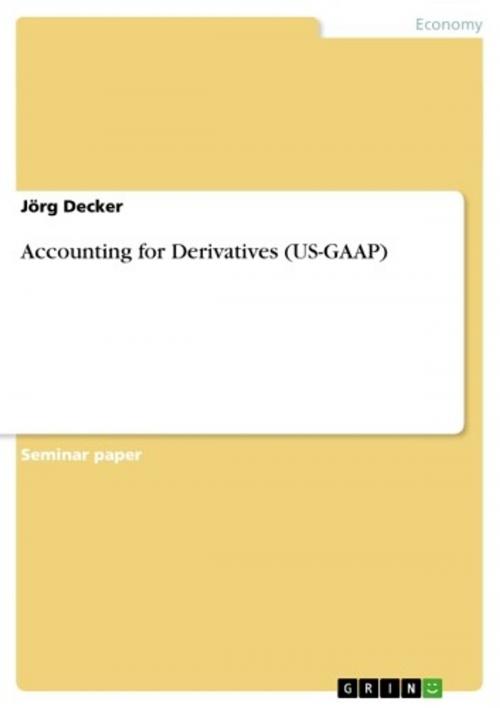| Author: | Jörg Decker | ISBN: | 9783638206440 |
| Publisher: | GRIN Publishing | Publication: | July 23, 2003 |
| Imprint: | GRIN Publishing | Language: | English |
| Author: | Jörg Decker |
| ISBN: | 9783638206440 |
| Publisher: | GRIN Publishing |
| Publication: | July 23, 2003 |
| Imprint: | GRIN Publishing |
| Language: | English |
Seminar paper from the year 2003 in the subject Business economics - Accounting and Taxes, grade: 1,7 (A-), Technical University of Braunschweig (Economics - Controlling), course: Intenational Accounting, 20 entries in the bibliography, language: English, abstract: Some years before the financial scandal of Enron, which was mainly caused by the misuse of derivatives, the Financial Accounting Standard Board (FASB) began deliberating on issues related to derivatives and hedging transactions.1 The cause of thinking about changes in accounting for derivatives was a problematic situation in 1986 (comparable to current situation in Germany). For example, the applicatory use was very complicated and transactions with derivatives were not transparent enough. There were only clear standards for a few product groups and transactions with derivatives were not reported on the balance sheet.2 In consequence, first in 1986, a work program called Project on Financial Instruments was founded.3 In 1992 the members of the FASB received the responsibility in working on derivatives and continued improving the existing statement for about six years in more than 100 meetings. In June 1998 (06/16/1998) the Statement for Financial Accounting Standard (SFAS) No. 133 'Accounting for Derivative Instruments and Hedging Instruments' passed as an outcome of these efforts and is valid for every entity.4 Some public voices say, it is one of the most complex and controversial standards ever issued by the FASB.5 Statement No. 133 replaced FASB Statement No. 80 (Accounting for Future Contracts), No. 105 (Disclosure of Information about Financial Instruments with Off-Balance-Sheet Risk and Financial Instruments with Concentrations of Credit Risk) and No. 119 (Disclosures about Derivative Financial Instruments and Fair Value of Financial Instruments). 6 Also FASB Statement No. 52 (Foreign Currency Translation) and No. 107 (Disclosures about Fair Value of Financial Instruments) were amended, by including the 'disclosure provisions about concentration of credit risk' form Statement No. 105 in Statement No.107. Despite the fact that the new Statement was issued in June 1998 it only was effective on financial statements for fiscal years beginning after June 15, 2000. [...] 1 Cp. Ernst & Young LLP (2002), p. 1. 2 Cp. Henne, T.(2000), p. 51. 3 Cp. Zander, D. (2000), p. 985. 4 Cp. Maulshagen ,A./Maulshagen, O. (1998), p. 2151. 5 Cp. International Treasurer (1999). 6 Cp. Ernst & Young LLP (2002), p. 1.
Seminar paper from the year 2003 in the subject Business economics - Accounting and Taxes, grade: 1,7 (A-), Technical University of Braunschweig (Economics - Controlling), course: Intenational Accounting, 20 entries in the bibliography, language: English, abstract: Some years before the financial scandal of Enron, which was mainly caused by the misuse of derivatives, the Financial Accounting Standard Board (FASB) began deliberating on issues related to derivatives and hedging transactions.1 The cause of thinking about changes in accounting for derivatives was a problematic situation in 1986 (comparable to current situation in Germany). For example, the applicatory use was very complicated and transactions with derivatives were not transparent enough. There were only clear standards for a few product groups and transactions with derivatives were not reported on the balance sheet.2 In consequence, first in 1986, a work program called Project on Financial Instruments was founded.3 In 1992 the members of the FASB received the responsibility in working on derivatives and continued improving the existing statement for about six years in more than 100 meetings. In June 1998 (06/16/1998) the Statement for Financial Accounting Standard (SFAS) No. 133 'Accounting for Derivative Instruments and Hedging Instruments' passed as an outcome of these efforts and is valid for every entity.4 Some public voices say, it is one of the most complex and controversial standards ever issued by the FASB.5 Statement No. 133 replaced FASB Statement No. 80 (Accounting for Future Contracts), No. 105 (Disclosure of Information about Financial Instruments with Off-Balance-Sheet Risk and Financial Instruments with Concentrations of Credit Risk) and No. 119 (Disclosures about Derivative Financial Instruments and Fair Value of Financial Instruments). 6 Also FASB Statement No. 52 (Foreign Currency Translation) and No. 107 (Disclosures about Fair Value of Financial Instruments) were amended, by including the 'disclosure provisions about concentration of credit risk' form Statement No. 105 in Statement No.107. Despite the fact that the new Statement was issued in June 1998 it only was effective on financial statements for fiscal years beginning after June 15, 2000. [...] 1 Cp. Ernst & Young LLP (2002), p. 1. 2 Cp. Henne, T.(2000), p. 51. 3 Cp. Zander, D. (2000), p. 985. 4 Cp. Maulshagen ,A./Maulshagen, O. (1998), p. 2151. 5 Cp. International Treasurer (1999). 6 Cp. Ernst & Young LLP (2002), p. 1.















